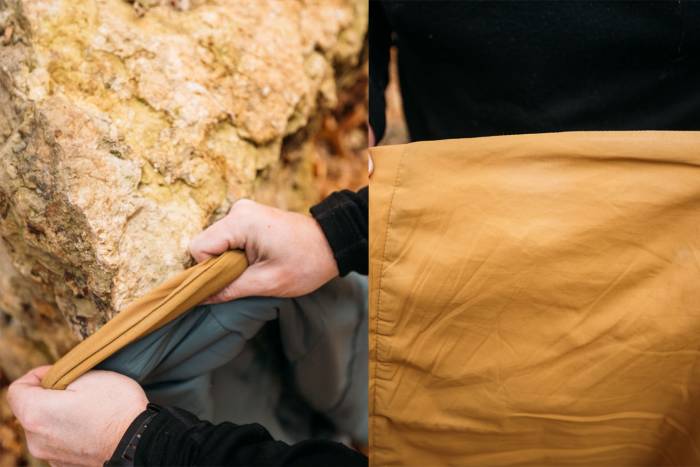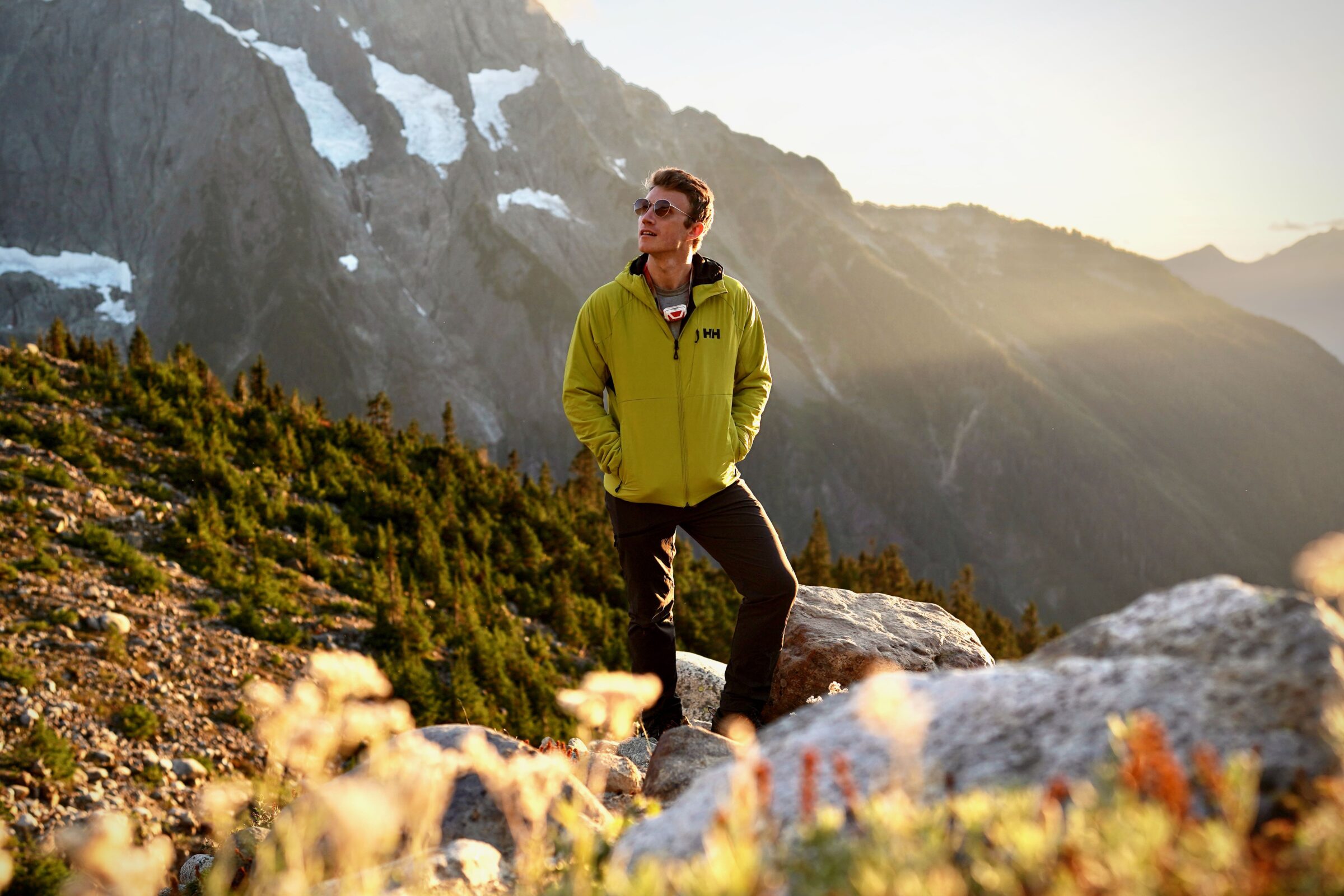The redesigned Arc’teryx Proton LT Hoody claims its fabric is 60 times more durable than the industry standard while remaining breathable and lightweight. So we put this jacket to the test.
Last fall, the Proton LT jacket received its first update in 3 years. Arc’teryx advertises this jacket as an intelligent insulating layer that could be the “ultimate multitasker” for any demanding outdoor activity in cooler temps.
It’s designed to be a durable active-insulation layer that lets air in and “breathes” while you’re on the move, like a hike or climb to the summit. And once you stop or slow down (reach the summit), it should retain heat so you don’t get too cold.
In short: We’ve spent 8 months testing this jacket in a variety of temperatures, conditions, and activities ranging from 50 degrees Fahrenheit with rain to below zero and snowing.
The Arc’teryx Proton LT Hoody has held up during all activities from rock climbing to bouldering, ice climbing, hiking, skiing, biking, and fly fishing. It excels in temps from zero to 45 degrees Fahrenheit. Overall, we’re impressed with the breathability, comfort, and durability of this all-around jacket.
Shop the Men’s JacketShop the Women’s Jacket

Arc’teryx Proton LT Hoody Jacket Review
The new Proton LT Hoody launched in the fall of 2019. It typically retails for $299, but the women’s version is on sale now for $179 at REI.
Who Is This Jacket For?
The Proton LT Hoody is for those who don’t stop adventuring when it gets cold. Arc’teryx designed this jacket to withstand the rigors of alpine and rock climbing, but you can wear it for almost anything.
Is the Proton LT Durable?
Arc’teryx developed a new face fabric called Fortius Air 20, which is claimed to be 60 times more durable than the industry standard (determined using the Martindale abrasion test). The Proton LT marks the first jacket to use the new fabric.
That’s fine, but we wanted to test it on real rock to see how it held up.
Each year, our editor climbs a glacial erratic in Wyoming, and this granite boulder is always the sharpest rock he touches. It seemed like a good yet cringe-worthy test. He aggressively rubbed against the granite while bouldering, and the jacket showed no signs of wear.

Several months later, we sport climbed on sandstone and sought out a sharp, pointed rock for another practical test. We applied firm pressure and scraped the jacket over the rock in several directions to simulate an armbar and other general climbing movement. All good!
We repeated the process a second time with even more pressure, and again, it didn’t scratch or tear. We were impressed.

Needless to say, it also held up to bushwhacking on hikes and other less abrasive outdoor activities.
How Warm Is the Arc’teryx Proton Jacket?
Warm AF! Off the crag, we also put the Proton through some icy paces. It managed to become a stalwart for the entire winter season.
If you’ve been to Minnesota in January, you know it gets cold here — brutally cold. The beauty of this jacket is that it works as well in 45-degree weather as a standalone jacket as it does in subzero temps with proper layering.
We donned the Proton LT on a late-night ice climbing adventure that saw temperatures dipping to -18 degrees. To combat the cold, we each wore a heavy merino base layer, the Proton LT, and a shell, and stayed comfortable for hours of climbing. This was one of several subzero pursuits in which the Proton kept us warm and comfortable.
On the flipside, this jacket will go into the closet once it hits 50 degrees for activities. You could wear it to 60 degrees if you’re just hanging out at camp at night, but that’s pushing it. Any warmer than that and you’ll be sweating.
For reference, it’s quite a bit warmer and heavier than the popular Arc’teryx Atom LT and Patagonia Nano-Air jackets.
Does the Jacket Breathe Well?
We’ve really come to love this jacket even more during shoulder seasons. Spring can be difficult to dress for high-output activities, as weather changes rapidly. Choosing a layer you can count on for breathability when it gets too warm, or added warmth when the temperature drops, is key.

Several times, we removed the Proton LT after activity and were shocked at the amount of moisture it pulled through the jacket away from the body. Even when the Proton was dark with sweat, our skin stayed dry and comfortable.
That moisture management comes from the Coreloft Compact 80 insulation found throughout most of the jacket. Arc’teryx created this fabric in house for this very purpose. The aforementioned Fortius 20 and a Dope Permiar 20 liner all work together to draw the sweat off your body and through the jacket quickly.
Other Jacket Highlights
We found the trim fit very similar to other Arc’teryx tops, and it allowed for freedom of movement. It also sports a hemlock drawcord at the waist for when you need to keep the jacket snug. A single chest pocket is handy for stashing smaller items.
The back of the jacket is a few inches longer than the front, which is nice when you’re climbing and biking. And, there are some exclusive colorways only available at REI.
A size medium weighs 13.2 ounces, which is about average for a jacket of this type. It’s certainly not the lightest insulation available, but it’s more durable and warmer than an ultralight puffy.
Room for Improvement
The hood fits great when you’re wearing a helmet, but at all other times, it’s a bit big. There’s a cinch cord so you can adjust the fit, but overall it could be smaller.
It costs $299, which is standard for this type of jacket, but it’s still a dent in the bank account. But the women’s jacket is on sale right now for $179!

Final Thoughts
It comes as no surprise that the Proton LT is a solid jacket. Arc’teryx has built its brand creating products combining innovative technical features with quality and durability. The Proton LT holds true to this Arc’teryx core.
We wore the Proton LT Hoody rock climbing, hiking, skiing, bouldering, and ice climbing, confident we would stay comfortably warm — but not too warm. Knowing that the jacket can hold up to rough use is a great perk that keeps you focused on your objective and not your gear.
While the Proton LT comes at a high price ($179 on sale), we think it’s worth it for the outdoor enthusiast looking for a cool-weather “quiver-killer” type of jacket that you can depend on day in and day out.









